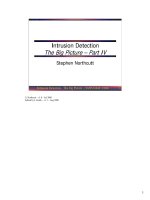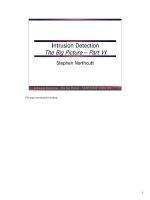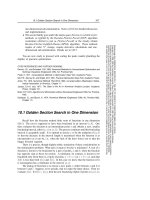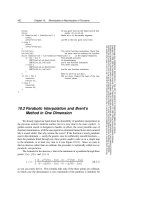Tài liệu Two Point Boundary Value Problems part 2 pdf
Bạn đang xem bản rút gọn của tài liệu. Xem và tải ngay bản đầy đủ của tài liệu tại đây (104.38 KB, 4 trang )
17.1 The Shooting Method
757
Sample page from NUMERICAL RECIPES IN C: THE ART OF SCIENTIFIC COMPUTING (ISBN 0-521-43108-5)
Copyright (C) 1988-1992 by Cambridge University Press.Programs Copyright (C) 1988-1992 by Numerical Recipes Software.
Permission is granted for internet users to make one paper copy for their own personal use. Further reproduction, or any copying of machine-
readable files (including this one) to any servercomputer, is strictly prohibited. To order Numerical Recipes books,diskettes, or CDROMs
visit website or call 1-800-872-7423 (North America only),or send email to (outside North America).
17.1 The Shooting Method
In this section we discuss “pure” shooting, where the integration proceeds from
x
1
to x
2
, and we try to match boundary conditions at the end of the integration. In
the next section, we describe shooting to an intermediate fitting point, where the
solution to the equations and boundary conditions is found by launching “shots”
from both sides of the interval and trying to match continuity conditions at some
intermediate point.
Our implementation of the shooting method exactly implements multidimen-
sional, globally convergent Newton-Raphson (§9.7). It seeks to zero n
2
functions
of n
2
variables. The functions are obtained by integrating N differential equations
from x
1
to x
2
. Let us see how this works:
At the starting point x
1
there are N starting values y
i
to be specified, but
subject to n
1
conditions. Therefore there are n
2
= N − n
1
freely specifiable starting
values. Let us imagine that these freely specifiable values are the components of a
vector V that lives in a vector space of dimension n
2
. Then you, the user, knowing
the functional form of the boundary conditions (17.0.2), can write a function that
generates a complete set of N starting values y, satisfying the boundary conditions
at x
1
, from an arbitrary vector value of V in which there are no restrictionson the n
2
component values. In other words, (17.0.2) converts to a prescription
y
i
(x
1
)=y
i
(x
1
;V
1
,...,V
n
2
) i=1,...,N (17.1.1)
Below, the function that implements (17.1.1) will be called load.
Notice that the components of V might be exactly the values of certain “free”
components of y, with the other components of y determined by the boundary
conditions. Alternatively, the components of V might parametrize the solutions that
satisfy the starting boundary conditions in some other convenient way. Boundary
conditions often impose algebraic relations among the y
i
, rather than specific values
for each of them. Using some auxiliary set of parameters often makes it easier to
“solve” the boundary relations for a consistent set of y
i
’s. It makes no difference
which way you go, as long as your vector space of V’s generates (through 17.1.1)
all allowed starting vectors y.
Given a particular V, a particular y(x
1
) is thus generated. It can then be turned
into a y(x
2
) by integrating the ODEs to x
2
as an initial value problem (e.g., using
Chapter 16’s odeint). Now, at x
2
, let us define a discrepancy vector F,alsoof
dimension n
2
, whose components measure how far we are from satisfying the n
2
boundary conditions at x
2
(17.0.3). Simplest of all is just to use the right-hand
sides of (17.0.3),
F
k
= B
2k
(x
2
, y) k =1,...,n
2
(17.1.2)
As in the case of V, however, you can use any other convenient parametrization,
as long as your space of F’s spans the space of possible discrepancies from the
desired boundary conditions, with all components of F equal to zero if and only if
the boundary conditions at x
2
are satisfied. Below, you will be asked to supply a
user-written function score which uses (17.0.3) to convert an N-vector of ending
values y(x
2
) into an n
2
-vector of discrepancies F.
758
Chapter 17. Two Point Boundary Value Problems
Sample page from NUMERICAL RECIPES IN C: THE ART OF SCIENTIFIC COMPUTING (ISBN 0-521-43108-5)
Copyright (C) 1988-1992 by Cambridge University Press.Programs Copyright (C) 1988-1992 by Numerical Recipes Software.
Permission is granted for internet users to make one paper copy for their own personal use. Further reproduction, or any copying of machine-
readable files (including this one) to any servercomputer, is strictly prohibited. To order Numerical Recipes books,diskettes, or CDROMs
visit website or call 1-800-872-7423 (North America only),or send email to (outside North America).
Now, as far as Newton-Raphson is concerned, we are nearly in business. We
want to find a vector value of V that zeros the vector value of F.Wedothis
by invoking the globally convergent Newton’s method implemented in the routine
newt of §9.7. Recall that the heart of Newton’s method involves solving the set
of n
2
linear equations
J · δV = −F (17.1.3)
and then adding the correction back,
V
new
= V
old
+ δV (17.1.4)
In (17.1.3), the Jacobian matrix J has components given by
J
ij
=
∂F
i
∂V
j
(17.1.5)
It is not feasible to compute these partial derivatives analytically. Rather, each
requires a separate integration of the N ODEs, followed by the evaluation of
∂F
i
∂V
j
≈
F
i
(V
1
,...,V
j
+∆V
j
,...)−F
i
(V
1
,...,V
j
,...)
∆V
j
(17.1.6)
This is done automatically for you in the routine fdjac that comes with newt.The
only input to newt that you have to provide is the routine vecfunc that calculates
F by integrating the ODEs. Here is the appropriate routine, called shoot,thatis
to be passed as the actual argument in newt:
#include "nrutil.h"
#define EPS 1.0e-6
extern int nvar; Variables that you must define and set in your main pro-
gram.extern float x1,x2;
int kmax,kount; Communicates with odeint.
float *xp,**yp,dxsav;
void shoot(int n, float v[], float f[])
Routine for use with
newt
to solve a two point boundary value problem for
nvar
coupled ODEs
by shooting from
x1
to
x2
. Initial values for the
nvar
ODEs at
x1
are generated from the
n2
input coefficients
v[1..n2]
, using the user-supplied routine
load
. The routine integrates the
ODEs to
x2
using the Runge-Kutta method with tolerance
EPS
, initial stepsize
h1
, and minimum
stepsize
hmin
.At
x2
it calls the user-supplied routine
score
to evaluate the
n2
functions
f[1..n2]
that ought to be zero to satisfy the boundary conditions at
x2
. The functions
f
are returned on output.
newt
uses a globally convergent Newton’s method to adjust the values
of
v
until the functions
f
are zero. The user-supplied routine
derivs(x,y,dydx)
supplies
derivative information to the ODE integrator (see Chapter 16). The first set of global variables
above receives its values from the main program so that
shoot
can have the syntax required
for it to be the argument
vecfunc
of
newt
.
{
void derivs(float x, float y[], float dydx[]);
void load(float x1, float v[], float y[]);
void odeint(float ystart[], int nvar, float x1, float x2,
float eps, float h1, float hmin, int *nok, int *nbad,
void (*derivs)(float, float [], float []),
void (*rkqs)(float [], float [], int, float *, float, float,
17.1 The Shooting Method
759
Sample page from NUMERICAL RECIPES IN C: THE ART OF SCIENTIFIC COMPUTING (ISBN 0-521-43108-5)
Copyright (C) 1988-1992 by Cambridge University Press.Programs Copyright (C) 1988-1992 by Numerical Recipes Software.
Permission is granted for internet users to make one paper copy for their own personal use. Further reproduction, or any copying of machine-
readable files (including this one) to any servercomputer, is strictly prohibited. To order Numerical Recipes books,diskettes, or CDROMs
visit website or call 1-800-872-7423 (North America only),or send email to (outside North America).
float [], float *, float *, void (*)(float, float [], float [])));
void rkqs(float y[], float dydx[], int n, float *x,
float htry, float eps, float yscal[], float *hdid, float *hnext,
void (*derivs)(float, float [], float []));
void score(float xf, float y[], float f[]);
int nbad,nok;
float h1,hmin=0.0,*y;
y=vector(1,nvar);
kmax=0;
h1=(x2-x1)/100.0;
load(x1,v,y);
odeint(y,nvar,x1,x2,EPS,h1,hmin,&nok,&nbad,derivs,rkqs);
score(x2,y,f);
free_vector(y,1,nvar);
}
For some problems the initial stepsize ∆V might depend sensitively upon the
initial conditions. It is straightforward to alter load to include a suggested stepsize
h1 as another output variable and feed it to fdjac via a global variable.
A complete cycle of the shooting method thus requires n
2
+1integrations of
the N coupled ODEs: one integration to evaluate the current degree of mismatch,
and n
2
for the partial derivatives. Each new cycle requires a new round of n
2
+1
integrations. This illustrates the enormous extra effort involved in solving two point
boundary value problems compared with intial value problems.
If the differential equations are linear, then onlyone complete cycle is required,
since (17.1.3)–(17.1.4) should take us right to the solution. A second round can be
useful, however, in mopping up some (never all) of the roundoff error.
As given here, shoot uses the quality controlled Runge-Kutta method of §16.2
to integrate the ODEs, but any of the other methods of Chapter 16 could just as
well be used.
You, the user, must supply shoot with: (i) a function load(x1,v,y) which
calculates the n-vector y[1..n] (satisfying the starting boundary conditions, of
course), given the freely specifiable variables of v[1..n2] at the initial point x1;
(ii) a function score(x2,y,f) which calculates the discrepancy vector f[1..n2]
of the ending boundary conditions, given the vector y[1..n] at the endpoint x2;
(iii)a starting vector v[1..n2]; (iv) a function derivs for the ODE integration; and
other obvious parameters as described in the header comment above.
In §17.4 we give a sample program illustrating how to use shoot.
CITED REFERENCES AND FURTHER READING:
Acton, F.S. 1970,
Numerical Methods That Work
; 1990, corrected edition (Washington: Mathe-
matical Association of America).
Keller, H.B. 1968,
Numerical Methods for Two-Point Boundary-Value Problems
(Waltham, MA:
Blaisdell).
760
Chapter 17. Two Point Boundary Value Problems
Sample page from NUMERICAL RECIPES IN C: THE ART OF SCIENTIFIC COMPUTING (ISBN 0-521-43108-5)
Copyright (C) 1988-1992 by Cambridge University Press.Programs Copyright (C) 1988-1992 by Numerical Recipes Software.
Permission is granted for internet users to make one paper copy for their own personal use. Further reproduction, or any copying of machine-
readable files (including this one) to any servercomputer, is strictly prohibited. To order Numerical Recipes books,diskettes, or CDROMs
visit website or call 1-800-872-7423 (North America only),or send email to (outside North America).
17.2 Shooting to a Fitting Point
The shooting method described in §17.1 tacitly assumed that the “shots” would
be able to traverse the entire domain of integration, even at the early stages of
convergence to a correct solution. In some problems it can happen that, for very
wrong starting conditions, an initial solution can’t even get from x
1
to x
2
without
encountering some incalculable, or catastrophic, result. For example, the argument
of a square root might go negative, causing the numerical code to crash. Simple
shooting would be stymied.
A different, but related, case is where the endpoints are both singular points
of the set of ODEs. One frequently needs to use special methods to integrate near
the singular points, analytic asymptotic expansions, for example. In such cases it is
feasible to integrate in the direction away from a singular point, using the special
method to get through the first little bit and then reading off “initial” values for
further numerical integration. However it is usually not feasible to integrate into
a singular point, if only because one has not usually expended the same analytic
effort to obtain expansions of “wrong” solutions near the singular point (those not
satisfying the desired boundary condition).
The solution to the above mentioned difficulties is shooting to a fitting point.
Instead of integrating from x
1
to x
2
, we integrate first from x
1
to some point x
f
that
is between x
1
and x
2
; and second from x
2
(in the opposite direction) to x
f
.
If (as before) the number of boundary conditions imposed at x
1
is n
1
,andthe
number imposed at x
2
is n
2
, then there are n
2
freely specifiable starting values at
x
1
and n
1
freely specifiable starting values at x
2
. (If you are confused by this, go
back to §17.1.) We can therefore define an n
2
-vector V
(1)
of starting parameters
at x
1
, and a prescription load1(x1,v1,y) for mapping V
(1)
into a y that satisfies
the boundary conditions at x
1
,
y
i
(x
1
)=y
i
(x
1
;V
(1)1
,...,V
(1)n
2
) i =1,...,N (17.2.1)
Likewise we can define an n
1
-vector V
(2)
of starting parameters at x
2
,anda
prescription load2(x2,v2,y) for mapping V
(2)
into a y that satisfies the boundary
conditions at x
2
,
y
i
(x
2
)=y
i
(x
2
;V
(2)1
,...,V
(2)n
1
) i =1,...,N (17.2.2)
We thus have a total of N freely adjustable parameters in the combination of
V
(1)
and V
(2)
.TheNconditions that must be satisfied are that there be agreement
in N components of y at x
f
between the values obtained integrating from one side
and from the other,
y
i
(x
f
; V
(1)
)=y
i
(x
f
;V
(2)
) i =1,...,N (17.2.3)
In some problems, the N matching conditions can be better described (physically,
mathematically, ornumerically) by using N different functions F
i
,i=1...N, each
possibly depending on the N components y
i
. In those cases, (17.2.3) is replaced by
F
i
[y(x
f
; V
(1)
)] = F
i
[y(x
f
; V
(2)
)] i =1,...,N (17.2.4)









